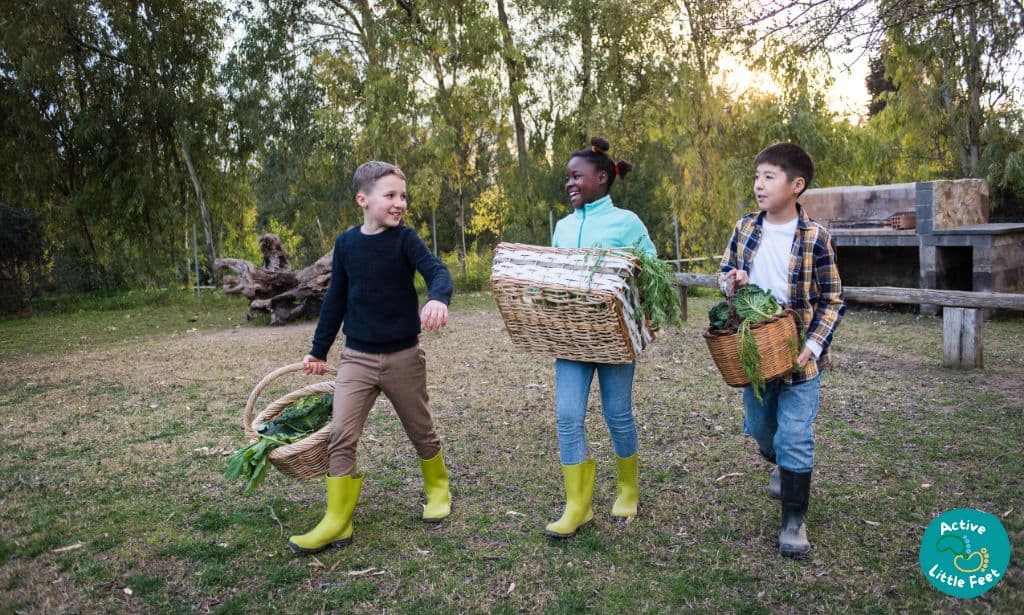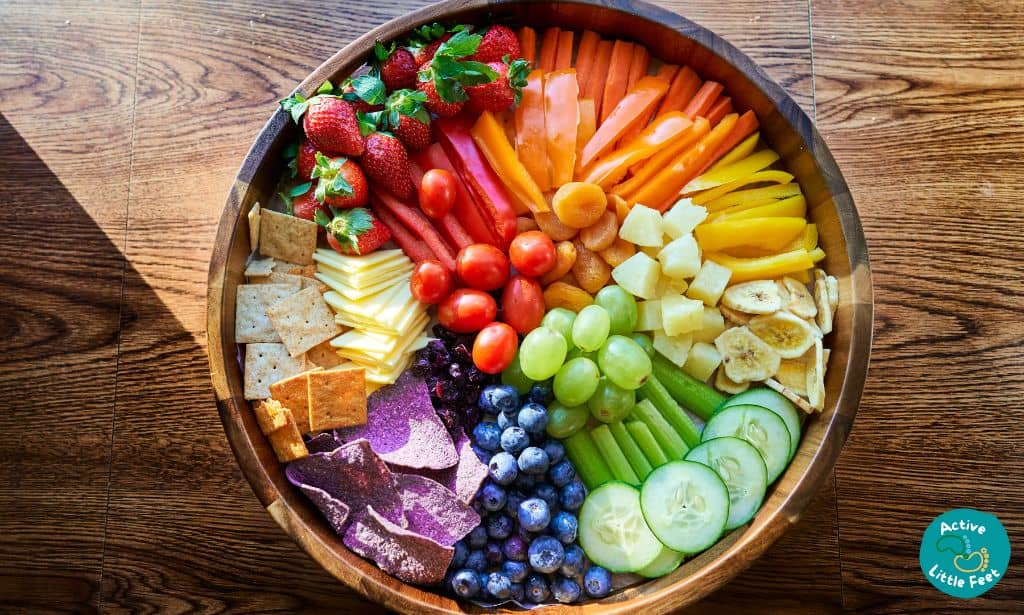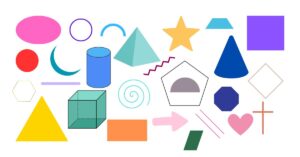I’ll be honest, as always- the idea of fruit and vegetable activities came about accidentally on one of those hectic mothering days. After what felt like the 70th time going to the kitchen to get my daughter something else to eat, I told her to sort out the fruits in the fruit bowl I had prepared for her. This, in my mind, will give me at least 30 minutes to finish an article I was writing without someone yelling “mom” at me.
It worked- for six minutes at least.
For my sister, the fruit and vegetable activities started to encourage her picky eaters to eat healthy foods. As most parents know, getting kids to eat their veggies can be quite a hassle sometimes. The activities we have here will help your child associate fruits and vegetables with fun and also distract them so they don’t realize what they are eating.
The interesting thing about this has been realizing the educational part of fruit and vegetable activities for young children. I have taught language, arithmetic, colors and soft skills like critical thinking and problem-solving with fruits and veggies. Plus it has been fun seeing if children know the difference between vegetables and fruits.
Ready to explore these playful learning activities? I promise they will be fun, even for you as the parent.
1. Sorting
We will start with this game because it was the genesis of this article and many more. The idea is to have different types of fruits or vegetables and have the child sort them severally.
The simplest for younger children is color sorting. You can do full (uncut) fruits or a prepared fruit salad. Provide colored bowls and tell the child to put fruits in the bowl that match their different colors.
Kids can also sort out according to size (big and small), different shapes, or separate fruits and vegetables. I made the game a bit challenging last month by printing pictures of vegetables and fruits or vegetable cards. My daughter picks and matches the fruits or veggies with their respective images.
How will this make the child eat, you ask? Well, she gets to choose a color for the day, and we will eat whatever fruit or vegetable is represented by that color. Yesterday we decided to eat whatever bowl was too full and this creates opportunities to introduce new fruits to them.
2. Flavor and Value Addition
My parents taught me about value addition when I was very young. While a glass of milk would cost $1, you can turn it into a milkshake and sell it for $3. Kids, in particular, will enjoy this more than plain milk.
My daughter has been having a blast adding value to different fruits and vegetables, and its awesome watching her brain work. You will have to come up with the ideas initially, but they soon start participating.
For example, cut a carrot or cucumber into strips and dip them in chocolate when eating. She has eaten four whole carrots this way in one sitting. My mom also cut cherry tomatoes into cubes, sprinkled some sugar, and handed us spoons to eat. And who doesn’t love celery stalks dipped in hummus or peanut butter?
Here’s a fantastic Vegetable Hummus Bites tutorial for kids.
My favorite so far however has been turning fruits and veggies into juice. Have the child participate in preparing the fruits and even putting them in the juicer or blender. They really enjoy drinking the juice that they have made.

3. Make Vegetable Soup
I know this is a form of value addition, but it involves a lot of veggies and fire so we will put it separately. If your kids prefer to eat something other than their veggies, making vegetable soup is a fun way to ensure the veggies get eaten anyway.
Like making juice, I involve the child in preparing the vegetables while we discuss how delicious the soup will be. Because we make the soup together, they are more interested in eating it, plus working with the vegetables teaches them a lot.
The fun part of this for me is coming up with different recipes using their favorite fruit and veggies.
4. Painting
Don’t worry, fruit and vegetable activities don’t always have to involve the real thing. This creative idea, for instance, only requires you to buy a coloring book with printed pictures of fruits and veggies for the kid to color. You can also search the internet for printable fruit and vegetable pictures and print a black-and-white page.
Allow your child to paint the pictures using crayons, markers or dot markers, but they are also free to use paint. It has been interesting to see how well our kids know colors, as well as their fruits and veggies, from the colors they use to paint.

5. Reading on Fruits and Vegetables
We have discussed the benefits of reading for and with your kids here. What you read must be educational, interesting and beneficial to the child. Sometimes we read about places, other times we read mythical stories that have lessons, and sometimes we read fruit and vegetable books.
Amazon has a great preschool theme collection, but we also use our local library a lot to source the books. Some great fruit and vegetable books I recommend for toddlers include Oliver’s Vegetables by Vivian French, Fruit Bowl by Mark Hoffman, The Vegetables We Eat by Gail Gibbons, and Eating the Alphabet by Lois Elhert.
Ensure you read this when the child is fully awake, not during bedtime, so they can understand and ask questions.
6. Gardening
Yes, you can teach kids how to plant and care for fruits and vegetables. Besides showing them where these things come from (because most kids think food items come from the supermarket), you also instill a sense of responsibility and appreciation for what they eat.
There are two ways to do this;
Visit an orchard
This option is best for fruits because most fruit trees don’t yield fast enough. Take a trip to a nearby orchard and let the child see where fruits come from and how they are picked. They will learn about parts of the plant, the importance of fruits and see different kinds of fruits. If possible, let them pick their own fruits and enjoy eating them.
Plant a garden
I love the idea of starting an outdoor garden in the backyard if you have one. You can plant all sorts of veggies and get the kids involved in the entire process. But you don’t necessarily need to plant a garden. You can plant one vegetable just to demonstrate. For example, you can cut a sweet potato top, preferably one with shoots, and plant it in a small container. Whether or not you add soil to the container is up to you because plain water will do just fine. You can regrow romaine end, potato, bell pepper or even a tomato.

7. A Veggie Basket
You need a lot of fruits and vegetables for this activity. I also prefer plastic fruits and veggies over real ones. Set the fruits and vegetables on a clean floor or a blanket and hand the child a basket to collect what they want.
The child can pick up the fruits and veggies randomly, or you can tell them what to pick and put in the basket. This activity will teach the child about colors, sizes and different fruits and it keeps them busy for a long time. Both of you get to pretend you are in the farmers market buying fresh fruits and having a great time. Imaginary play is a critical part of brain development and learning.
8. Fruit and Vegetable Stamping
For this, you will need;
- Dry fruits or vegetables, i.e. apple slices, carrots, pears, celery
- Dry fruits or vegetables, i.e. apple slices, carrots, pears, celery
- Edible paint
- Edible paint
- Piece of paper
Cut the fruit or vegetable in half vertically so it has a flat surface. Dip the flat surface in paint, or apply paint on it using a brush. Carefully place the flat surface with paint on a blank sheet of paper to make a stamp. It’s just like hand prints but with vegetables or fruits.
9. Sensory Bin
Remember how we make a sensory bin for toddlers? This time, we will add a dry sensory substance to the basin or sensory table. Think beans, colored rice or sand. When the basin is half or three-quarter full, hide plastic fruits and vegetable shapes in different sizes for the child to find.
I like it when they find a vegetable and name it because it feels more like an achievement.

10. Puzzles
How about playing a puzzle with fruits and vegetables? The board will have pictures of the fruits or veggies, and respective pieces are made to fit those squares. The child will match each fruit to the correct box until the puzzle is complete.
Speaking of which,check out our kindergarten fruit and vegetables word search puzzle for kids. It’s absolutely free and a fun way for them to learn new words and get all the benefits of solving puzzles like improved memory.
11. Grocery Store Role Playing
This idea is courtesy of Kim Kardashian’s Kids playroom, which is fitted with a pretend grocery store that also works and a fully furnished play kitchen. If you have the budget, what she has would be perfect for toddlers because there is nothing pretend about it, except the fake fruits and vegetables.
However, you can do with what you have as long as the child knows you are role-playing a grocery store. Have a pretend cash register, produce section and people, who, in this case, are you and the kids. Our daughter loves selling vegetables to me and getting fake money, while I enjoy teaching them vegetable names.
12. Make Fruits with Play dough
Want to test how well your child knows their fruits or veggies? This activity is an excellent way of building creativity as well as fine motor skills. Provide enough play dough and tell the child to make different fruits and vegetables for you. You can also provide flash cards or printed fruit and veggies just for reference. This game is more exciting if there’s more than one kid so they can compete, help each other and build on their social skills.
13. Make Fruit Face
The last fruit and vegetable activity for toddlers is quite funny, so be ready for some chuckles. In essence, you will be making a person’s face but with fruits and vegetables. For instance, you can add a carrot as the nose, tomatoes as the eyes and bell peppers as the ears.
Let the child go crazy with whatever fruit or vegetable they want to add to the face, and then watch how funny the end result is. Again, it is a much better game if more than one kid is involved, but you can join in and have a blast with your toddler.
So, there you have it- 13 simple fruit and vegetable-related activities for toddlers and beyond. Check out these articles for more fun activities to do with your child.




